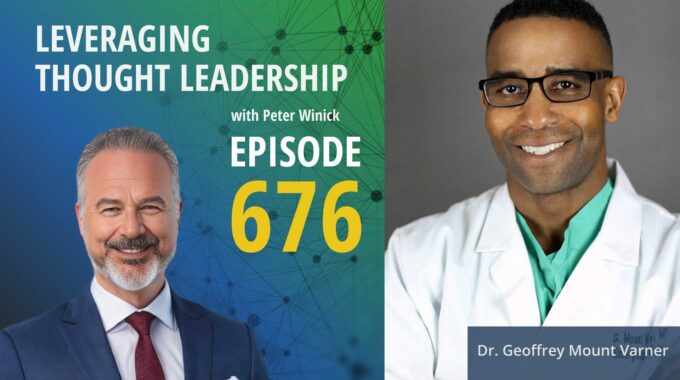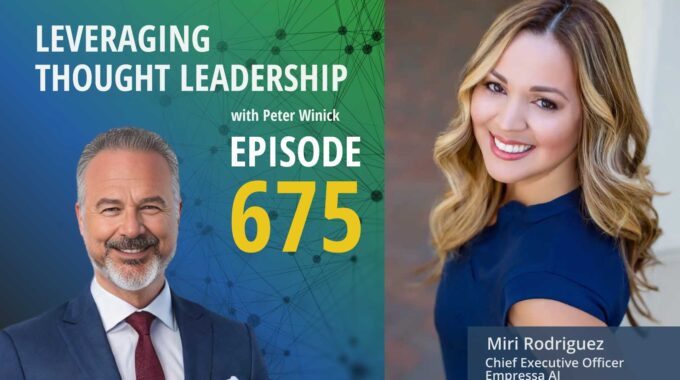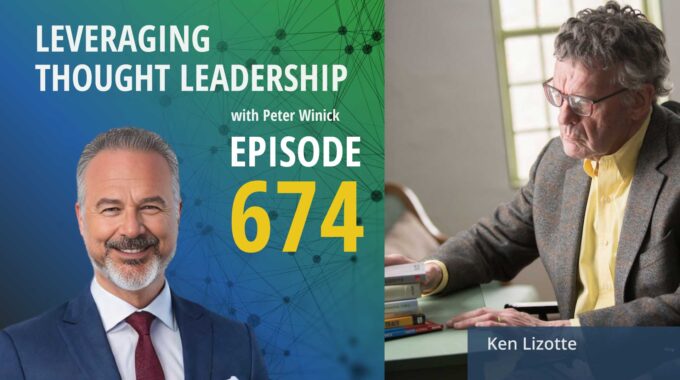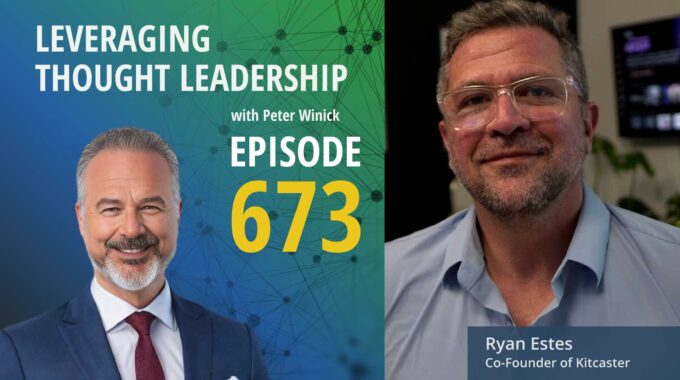The leadership advantage of acting with clarity, confidence, and purpose. This episode explores how leaders…
Collaborating to Join Research with the Applied in Thought Leadership | Jim Kouzes
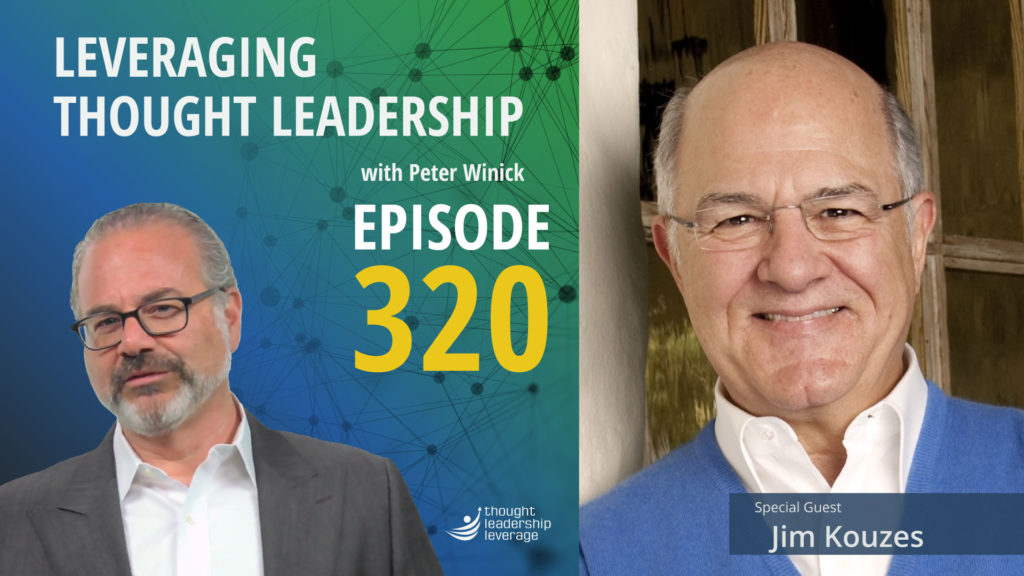
Codifying Concepts by Collaborating to Create Thought Leadership.
An interview with Jim Kouzes about collaboration, codifying concepts and making evidence-based research into practical content.
Today’s guest is Jim Kouzes. He is the co-author with Barry Posner of the award-winning and best-selling book, The Leadership Challenge. He’s also the Dean’s Executive Fellow of Leadership, Leavey School of Business, Santa Clara University.
Jim tells us about his first meeting with Barry and how they quickly became best friends. That friendship and their common interests led to writing The Leadership Challenge, which has sold more than two million copies worldwide!
Jim’s focus on the applied and Barry’s emphasis on research allowed them to develop the Leadership Practices Inventory (LPI). The LPI is a standard 360 leadership assessment. Jim explains the process of creating LPI. He shows how real-life examples play heavily into the ability of clients to grasp the concepts.
The COVID-19 pandemic has changed the way many people work and think. Jim discusses the changes in leaders and what employees look for in leadership due to the pandemic. He speaks about whether we can expect these changes to subside as we move forward or if some of them will become the new norm.
If you want a deep understanding of how evidence-based research can become applied skills you can use in daily life, this is a great episode for you!
Three Key Takeaways from the Interview
- When collaborating on thought leadership, try to work with those who have complementary skills and not competing interests.
- Your thought leadership should not include anything you cannot factually demonstrate.
- Real-life stories of how your thought leadership has worked can help others understand the principles of your content.
If you need a strategy to bring your thought leadership to market, Thought Leadership Leverage can assist you! Contact us for more information. In addition, we can help you implement marketing, research, and sales. Let us help you so you can devote yourself to what you do best.
Transcript
Peter Winick And welcome, welcome, welcome. This is Peter Winick, I’m the founder and CEO of Thought Leadership Leverage, and you’re joining us on the podcast today, and my guest is the esteemed Jim Kouzes. And let me just give you a highlight of Jim’s background, as I’m really excited about today. He’s the coauthor, with Barry Posner, of the award-winning and bestselling book The Leadership Challenge. Any of you that are the business book space. When I tell you that they sold two and a half million copies your jaws will probably drop because most of us are trying to sell two and a half thousand copies in this market. So that’s a major accomplishment. The sixth edition of The Leadership Challenge was released in 2017 and is now available in 22 languages. Jim and Barry also develop the highly acclaimed Leadership Practices Inventory known as LPI, which is sort of the standard 360 leadership assessment. And then I can go on and on and tell you about Jim’s accolades and top 30 and been in The Wall Street Journal. But let’s just let’s just – I’ve been – thank you for joining us today.
Jim Kouzes Hey, Peter, thank you very much for the opportunity. It’s good to see you and be with you.
Peter Winick My pleasure. So you’ve been at this for quite some time and you typically came at it as an extension of your academic career. Right. So it is, in some instances, more of a logical linear path than many thought leaders take. But give me a sense, if you just sort of look back over the last couple of decades and say, well, what’s the same and what’s changed when it comes to being a follower?
Jim Kouzes Well, Peter, I had a very serendipitous career, meaning a little bit of luck, some professional involvement with various associations and then the continuous learning which I love to do. Probably why I’m in this field in the first place. So I started out when I was in the Peace Corps, actually in education, I was a teacher in the Peace Corps. Sixty seven, sixty nine in Turkey. I taught school and I fell in love with education. And decided I would switch from wanting to be an ambassador to teaching, came back to the US and got a job teaching adults, not high school kids like I had thought I would. And that led me to an into adult education, applied behavioral science, and then I directed a couple of university centers where I dealt with executives, improving their skills and abilities after graduating with an MBA or bachelor’s degree. And they’re at work wanting to become better leaders hooked up with Barry Posner at Santa Clara University. And I found we had some common interests and that led to our exploring leadership together back in the early 80s, and the first book came out in 87 and been at it ever since.
Peter Winick So stay on the collaboration with Barry for a while because there are very foremost, not all, you know, authorship thought leadership is an individual sport, not a team sport, not a partnership. There have been examples of the Heath Brothers and a couple of others, but not that have been at it so long together and continue to raise the bar collaboratively. I was listening to an interview the other day with Kahneman talking about his relationship with them and what he said something to the effect of. Every time I had an idea and shared it with him, he gave it back to me better and I thought that was a really beautiful distillation of an amazing collaboration. So tell me a little bit about your collaboration with Barry.
Jim Kouzes I can recall very clearly the day we met, I was in Santa Clara University at the Executive Development Center, unpacking my boxes, moving into the office invitation of the dean of the business school, Andre Delvecchio, inviting me to join. That’s the director of the Executive Development Center. And then again, this knock on the door and. This guy said, you’re in my office. Oh, excuse me, I’m sorry I thought this, the dean told me this was what was my office, and they burst out laughing. And he said, Yeah, well, it was, was my office. It’s now your office. Welcome to Santa Clara University. That was Barry Posner. You know, that was an introduction to both his imposing height and also his humor, but more importantly, his interest in collaborating and working with others. And so Barry reached out and said, Look, if you want to, you know, get to know folks on the campus, you need some orientation and walk around, take you to the faculty club. Welcome to Santa Clara. We’re glad you’re here. And oh, by the way, I do teach in the Executive Development Center. So if you’d like to me to continue that, let’s have a chat and I said, Let’s do it. And he one became a coauthor to Has. He’s been my best friend. And he and his wife and my wife, we get together regularly for dinner and we enjoy each other’s company and bake brownies for each other. And so it’s been one of those relationships that just been marvelous, both personally and professionally. But I think it came about because we found we had common interests and yet we weren’t competing. I wasn’t on the tenure track. I was in the executive government center, so I was an administrator and he was on the tenure track, so we weren’t competing for one spot on the faculty. He could do his thing. I could do mine. I had a very strong interest in the applied side. Barry Harris has a stronger urge to this day. He’s now a chaired professor there continues on in Santa Clara. I wanted to work on the applied side where helping executives to put into practice what we can learn from our research. And I say our in the broader sense of all of us in the applied behavioral sciences and specifically what Barry and I researched as well. And so there was a complementary there were complementary skills and interests. And I think that probably more than anything kept us working together because I added value, he added value. But we didn’t really compete with each other professionally.
Peter Winick Right. Right. I mean, I think that lack of competition is if you’re both going after that same one seat in a game of musical chairs, that’s really hard to be, you know, collaborative in friends and it changes the energy. I want to talk a little bit about sort of the modalities, right? So over the years, obviously, being an academic executive, you’ve done your fair share of keynote speaking. That world has changed a bit thanks to thanks to COVID, but you’ve really done an amazing job of codifying and institutionalizing the leadership challenge. So I find my experience because I was a fan for a long time is it’s not based on charisma or, you know, woo-woo. There is so much science underneath it. And then you get to the LP IP. So tell me a little bit about how you went about sort of getting the getting the content so solid and then moving it into the LP, which it’s, you know, everybody does. How do you measure leader leadership and how do you assess it and all that? And you said, well, one step and step into my office, if you will.
Jim Kouzes Exactly. I think you just articulated probably to two of the three pillars the two that really have worked for us over time. People give us feedback that these are the reasons why they like our work. First of all, it’s evidence based. We don’t say anything that we can’t demonstrate is if you do this, you are more much more likely, significantly more likely to be successful than if you don’t do this. And we also provide. Real life experiences, real life managers and executives, this isn’t a fable. This is not a story we made up. We talked to the real people doing it. And in each of our books we have in the neighborhood of 30 to 50, examples from working professionals in leadership roles and what they did when they were at their best. So it both provides a rich example from practitioners –
Peter Winick Because one of the things I found over the years is that, I mean, academics live in evidence that by definition, yeah, part of what they do. Very few, like you can probably count on maybe a dozen, I don’t know, are able to take that evidence and translate it in a way that is readable because, you know, to become an academic, they beat it into you to produce academic papers, which frankly, nobody wants to rewrite. Like, you know, I don’t want to beat it by the time you’re right. But so, so you know, you look at some of the amazing folks that have come out of academia that have crossed the chasm, if you will, to literally not, you know, to make something readable and digestible and whatever without having to go through an Alpha Q sort or whatever. So how was that for you? Because that’s not an easy bridge to cross.
Jim Kouzes Well, I think both Barry and I. Like working with executives and helping them apply what they learned from us. Sure. Oh, Barry and I have a mindset of going from what we find in the research to be true. You know, one finding being just part of our model that leaders the foundation of leadership is personal credibility. OK, that’s great. So we want honest leaders, we want competent leaders. What’s that look like in practice? How do does a constituent, a follower, know whether somebody is credible or not credible? So we ask the next question. So what does that look like in practice? And to that question for that particular finding, people told us, You do what you say you will do is he would ask, why would you do what you say you would do? So we keep asking the questions. The next question what does this look like in practice? How do you do that? Give us an examples.
Peter Winick Or conversely, your questions are in English. Those are conversational AI systems like a real conversation between two humans, which is not always what you get, right? So that’s the secret sauce. Is it just that? Yeah, it’s authentic.
Jim Kouzes We just we love learning from people who are practitioners out there. Doing our research started by asking. Tell us about a time when you were at your best as a leader. What did you do? And then taking that information and seeing that there were patterns there that emerged from that. We called them the five practices of exemplary leaders. And our questionnaire, the leadership practices inventory is behavioral and asked people to look at the behavior of someone and give them feedback. Are they doing this behavior and how frequently are they doing it? So we love to do the research to make sure that there’s the evidence there that supports these hypotheses. Let me help you do this, then this will happen. But we also want to make sure that when people experience this or read it, they can use it. They can put it into practice.
Peter Winick And maybe they know the recipe, the balancing act, because I just finished reading your new book and I love the evidence. But I would argue that if it wasn’t filled chock full of real stories of real business people that highlighted what the data brought to life, I don’t think it would. You know, I don’t think I would be able to internalize it as quickly as easily as make it as approachable because numbers are numbers and data is data. But the one two punch of and here’s a story that shows that, you know, Leader X and Company Y did this interesting, interesting.
Peter Winick If you’re enjoying this episode of Leveraging Thought Leadership, please make sure to subscribe. If you’d like to help spread the word about our podcast, please leave us a review and share it with your friends. We’re available on Apple Podcasts and on all major listening apps, as well as at Thought Leadership Leverage dot com forward slash podcasts. So what do you see? What are some of the things over the years that you might have thought? Like, I don’t know if this will go anywhere and then went somewhere, sort of to a positive surprise.
Jim Kouzes Well, as any first author will tell you, you have aspirations for your book being adopted and being used in business and in potentially business school courses, but you never really know, and we were fortunate. And again, in asking people why they purchased our stuff, why they used our stuff, they said, well, because it’s practical and because there’s evidence behind it. So I think going in, we had this mindset of making it practical, usable, applied and people gave us the feedback that that’s what they wanted. So I think serendipitously. We presented the material initially with that in mind, making practical and applied, and then we had material that helped to support that. So somebody coming through a workshop or a seminar with us then had something they could take away and put into practice. And that is how we wrote. And that was how we related the material, talked about and spoke about it, developed others around it. So I think it sustained itself for that reason.
Peter Winick You know, I’d say it’s also very grounded. So one of the things that we’re seeing in the marketplace now is pre-COVID many speakers and got to name names. There was a lot of sizzle and not a lot of steak. Right? They had charm or charisma or energy, or they could be funny or wonderful accent or whatever, whatever, whatever. And that would carry the day for 60 Minutes on stage at an event in Denver or Las Vegas or whatever. But it didn’t really stick. You know, three days later, somebody might remember a snide remark or a little data vignette or something like that. You guys never really went that route. Not that your work wasn’t entertaining, but it wasn’t designed to be. Entertainment was designed. Education first delivered in a very pragmatic, practical way. So I would say that we’re the world is coming back to that now from Kobe because we don’t really have the time for the entertainment stuff for all year. You want that you can go to Netflix or, you know, go watch a TED talk or something like that. Yeah, yeah. Was that a conscious decision or just sort of you guys being you?
Jim Kouzes I I think it’s us being us. You know, Barry, if you if you experienced Barry, you’ll find that he’s very funny when he interacts and so people are greatly entertained when he works with them. But you know that this guy is a solid academic and he knows his stuff. And if you are with me, I’m a little bit more serious. And people know that my concern is for whether or not you can use this. And I think that has helped to sustain us. Hopefully, you know, when I speak, I’m pretty out, you know, outspoken and dynamic and energetic on this stage, and I need to be that way to keep the audience.
Peter Winick But there’s a difference between having stage presence. Yes. And the gravitas underneath it, that is really the star. So I would argue it’s never meant as a compliment that it’s not that you’re the star. The work is so amazingly wonderful. You’re just sort of just the messenger, which is kind of cool.
Jim Kouzes Yeah, exactly. I think it is. It’s just one of those serendipitous happenings that when we teamed up, Barry was again more. Well, what’s the evidence here? And I was, yeah, we got the evidence. But so what? How do people put this in finding into practice? And those two conversations always got us, I think, to a better place. I was challenged if I’ve made some assertion about, you know, here’s what these stories tell us about what executives do. And Barry would say, Well, OK, but prove it. Let’s do some research to find it. Barry would have offers something from the academic literature, and I would say, Well, great, but how do we use that? How would you use that as a manager in business? So we find that people work are higher performers from the standpoint of their constituents. In other words, they were seen as more effective leaders when they, we call it, encourage the heart when they recognize and reward people. Well, that’s great. But how do you do that on a day to day basis in business? And so those how that conversation
Peter Winick is critical because I can literally see the faces of many heads of H.R. or leaders where the CEO comes in with the proverbial book under their arms. Oh, gee, I just read this over the weekend and we’ve got to do this right. Let’s bring this guy in or this gallon and we’ve got to do this and they patient sweating because they’ve already got their two year plan. And I think if they were to sort of politely, they do this now and sort of say, Well, you know, you know, prove it, OK, that book was great. It’s entertaining, and maybe people should read it, but it doesn’t mean it represents a capability that we can develop in our people versus it’s just a quirky person who’s a great thinker and has an interesting perspective. And there’s a difference between that and a home because I could, you know, manage and think differently
Peter Winick after going through, you know? Right? I mean, when you break that down, I’m like, Oh, OK, so I’ve got I’ve got to be
Peter Winick trustworthy, OK, I got it. I going to work on that like versus someone that’s got the great story. In any case, what do you looking forward? What I always hate to ask you that just finished a book. What’s next? But you know what’s next?
Jim Kouzes Well, right now, Peter, we’re working on the seventh edition of the leadership challenge, so that’s our classic book. We first came out in 87. About every five max, six years in between, we do a new edition. So 2017 was the last one to 2022. 23 will be when we come out with the new edition. The pandemic has enabled us to look at things a little bit differently through a different lens. How does a global crisis impact leadership and what’s the data telling us about that? We are beginning to tease out some things that appear differently. For example. We have found that when we ask people, what do you look for and admire in a leader, someone whose direction you would willingly follow, which is one of our surveys, not the FBI, but a different survey with characteristics or qualities people want? Credibility is still at the top, so honest and trustworthiness, competence, expertise at the top, but caring and supportive have significantly increased. And interestingly enough, it’s desired more even more by female respondents than male respondents. That’s it. So if you if you just take that one and if that trend holds, we’re going to do another survey toward the fall to see if anything changes. But in this last year, that’s one of the things we’ve noticed. So during times of crisis, difficulty adversity, people want more supportive, caring leaders that will then influence what we write in the next edition. So while the model has remained the same and that next edition will be writing about some of these external influences that help us when times are tough and difficult. Give us some guidance around that. So that’s what we’re focused on right now and also focus on this most recent book, Everyday People Extraordinary Leadership, where we’re wanting to do more to develop leaders who aren’t informal positions don’t have titles as managers or executives. Those two things are where we’re focused right now and thinking ahead the next two or three years.
Peter Winick Absolutely. Well, that’s actually keep you out of trouble for a while.
Jim Kouzes Yeah. At my age, it certainly will.
Peter Winick Well, I appreciate your time. I admire your work from afar for for many years, and it was great to have an opportunity to chat with you today. Thank you so much.
Jim Kouzes Peter, you are most gracious. Thank you for the great work you are doing. You’re really having an impact on folks out there and I do appreciate what you’re doing and thanks for the opportunity to share our story with you.
Peter Winick Thank you. To learn more about Thought Leadership Leverage, please visit our web site at ThoughtLeadershipLeverage.com to reach me directly. Feel free to email me at Peter at ThoughtLeadershipLeverage.com and please subscribe to Leveraging Thought Leadership on iTunes or your favorite podcast app to get your weekly episode automatically.



